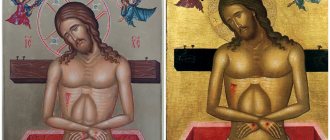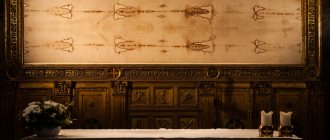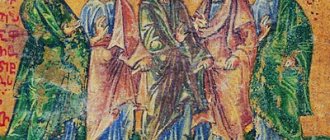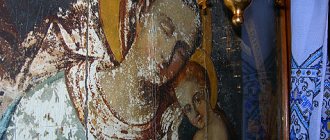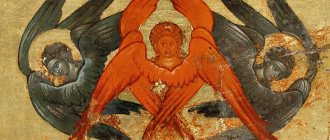One of the most venerable is the crown of thorns of Christ - a symbol of His suffering and the power of faith in humanity! Christian relics have divine powers. All because at one time they had contact with the Almighty.
At one time, this news spread throughout the Internet, attracting the attention of believers. We are talking about the fire in Notre Dame Cathedral, which occurred on April 15, 2021. At first glance, the fire caused great damage to the most magnificent building. However, only a few guessed what danger one of the main relics of Christianity was in – the crown of thorns of Jesus Christ. This shrine is important for believers. And there are a number of important reasons for this.
Why was Jesus Christ crucified?
Gospel story [edit | edit code]
Three evangelists write about the placing of a crown of thorns on Jesus Christ:
...and having woven a crown of thorns, they placed it on His head and gave Him a reed in His right hand; and, kneeling before Him, they mocked Him, saying: Hail, King of the Jews! (Matt. 27:29)
...and they clothed Him in scarlet, and wove together a crown of thorns, and laid it on Him (Mark 15:17)
And the soldiers wove a crown of thorns, put it on His head, and clothed Him in scarlet robe (John 19:2)
It is not written in the canonical Gospels about when the crown of thorns was removed. Some artists paint Jesus Christ on the cross with a crown of thorns.
Interesting Facts
- Division of the crown. This has already been discussed. The crown, during the French Revolution, was divided into three parts. Each of them survived and has survived to this day.
- Proof of Christ's torment. The crown brought the Savior much suffering. This can be judged by the Shroud of Turin, in which his body was wrapped. From the remaining traces we can conclude that the relic inflicted 13 wounds on the forehead and 20 on the back of the head.
- Storage method . Any plant decomposes after some time. But the special crystal case in which His crown is kept does not allow the plant to lose its appearance. In addition, the bush from which this “crown” is woven is strong enough to stand the test of time.
- Number of spikes . The original crown had up to 70 thorns. But skillful merchants, before selling the relics to the king of France, cut them off and gave them to monasteries around the world, as a piece of Him.
The crown of thorns is considered a symbol of the suffering of Christ. For the sake of humanity, he accepted the cup of trials and drank it to the dregs. The relic is of great importance to all Christians. Thanks to the care of people, this relic was not lost in the past, which is something we can’t help but rejoice at. Today, anyone can come to Notre Dame Cathedral and offer a prayer to the crown.
In the Middle Ages [edit | edit code]
The crown of thorns was originally located in Jerusalem, but in the 1060s it was transported to Constantinople [1]. Nicholas Mesarit, Metropolitan of Ephesus (XII - early XIII centuries) - theologian, church and statesman reports that in 1201 in Constantinople, in the temple of the Virgin Mary (ancient Greek τοῦ Θάρου - at the lighthouse
) - in a church intended for everyday liturgy in the presence of the emperor and his family, as well as for solemn services on the 1st day of the year, May 1, on the day of remembrance of the prophet Elijah (in the presence of the synclit), on Maundy Thursday and on Holy Saturday, the following relics were kept: the crown of thorns of Christ, the tunic of Christ, the staff of Christ, the whip of His flagellation, the holy nail, the spear of Longinus, particles of the sandals of Christ (brought by Emperor John Tzimiskes from Palestine in 975) [2].
During the Fourth Crusade, Constantinople was sacked in 1204. The relics that were in it were taken away by the crusaders, including the Crown of Thorns. In 1239, Saint Louis purchased the Crown, according to some sources, for a huge sum of 135 thousand livres at that time from the Latin Emperor Baldwin II. More precisely, Baldwin II pledged the Crown of Thorns to the Venetians, from whom it was redeemed by Saint Louis. In 1239, during a procession to Sens, Saint Louis and his brother Robert d'Artois, barefoot and wearing simple shirts, carried a shrine with a Crown of Thorns [3]. Then the Crown of Thorns was delivered to Paris, where particles of the Holy Cross, the Spear of Longinus and other objects testifying to the Old and New Testaments were later brought. To store the sacred relics, Saint Louis ordered the construction of a special church, Sainte-Chapelle, in Paris (the chapel of the royal palace, the foundation was laid in 1242) and in the same 1239 he temporarily placed the Crown of Thorns in the city cathedral [4]. In 1246, the Crown of Thorns was moved to the Sainte-Chapelle chapel [5].
In the Treatise on Relics, written in 1543 by the Protestant John Calvin and subsequently published many times, it is written that there were so many parts of the Crown of Thorns that if they were collected, you would get more than four crowns. They were: the third part of the crown at Sainte-Chapelle in Paris; three spikes in the Roman Church of the Holy Cross; many thorns in the Roman Church of St. Eustace; many thorns in Siena; one spike in Vicenza; five thorns - in Bourges; in Besançon, in the Church of St. John - three; Mont Royal (French Mont-Royal (Sarreinsberg)) - three; in the Cathedral of Oviedo in Spain; to the Cathedral of St. James in Galicia - two; in Albi - three; in Toulouse; Makone; Charroux (Vienne) (French: Charroux (Vienne)) in Poitou; in the Basilica of Notre-Dame de Cléry-Saint-André (French: Basilique Notre-Dame de Cléry-Saint-André); Saint-Flour (Cantal); Saint-Maximin-la-Sainte-Baume (French: Saint-Maximin-la-Sainte-Baume) in Provence; in fr. l'abbaye de la Salle; in the parish church of Saint Martin in Noyon [6].
What did the crown of thorns consist of?
The presented shrine managed to find its way into our time and exists now. It is a wreath woven from durable stems of a thorny plant. To make the victim experience even more suffering, jujube stems were added to the composition of the crown. It is this type of shrub that has a huge number of sharp thorns. Researchers count about 70 thorns that caused excruciating pain to the Savior.
There is information according to which in the 13th century the crown had a tendency to bloom. Since the problem is to preserve the bush in its original form, it was placed in a crystal case, which was also sealed for greater preservation. Observing the relic, you will notice that the case has cuts with gold staples.
During the French Revolution, the crown was divided into three parts. So the believers wanted to protect the relic, preserve it for the next generation. With God's help, we managed to preserve all three parts, which allowed the crown to acquire its single form.
In heraldry [edit | edit code]
The crown of thorns is the central element of the Order of the White Movement “Sign of the 1st Kuban (Ice) Campaign.”
We want to look at several myths about Jesus Christ. Until recently, the so-called mythological school, relying on the lack of both the sources themselves and the information contained in them, considered the founder of Christianity as a religious fiction, and not as a real historical figure. However, the opposite position also has its own compelling arguments.
Supporters of this view quite reasonably stated that since not a single non-Christian author of the 1st - early 2nd centuries mentioned such an outstanding personality, it means that he did not really exist.
The references to Christ found in such ancient authors as Josephus, Tacitus and Pliny the Younger, who were quoted by Christian apologists in their writings, were perceived as forged, inserted into the text by later Christian scribes. Currently, these evidences are approached more cautiously, without denying them indiscriminately, although there is clearly not enough objective evidence in favor of the existence of the real Jesus.
Indirect evidence usually includes not only manuscripts, but also archaeological data confirming biblical stories. In particular, in 1961, during excavations in Caesarea in Palestine, a group of Italian archaeologists discovered a fragment of a granite slab with a badly damaged Latin inscription, which mentions the names of Tiberius and Pilate. It should be noted that Pilate’s name is rarely mentioned anywhere except in the Holy Scriptures.
At one time, the greatest expert on Roman history, Nobel Prize winner in literature Theodor Mommsen, noted that Pontius Pilate, by his appointment as iure gladii (having the right to carry out the death penalty), should have been called not a procurator, but a prefect. By the way, only Tacitus was named procurator of Pilate. In the gospels written in Greek, he is called simply “ruler”; in other ancient authors, Pilate is sometimes “ruler”, sometimes “viceroy”, sometimes “manager”. Pilate bore the honorary title of “friend of Caesar” - amicus Caesaris, which, connected with the highest positions - legate, prefect, proconsul and others, indicated a close relationship with the emperor himself. The found inscription confirmed the brilliant guess of the brilliant German scientist T. Mommsen.
Description
The crown is a wreath woven from strong branches of a thorny plant, to which are added jujube stems. This shrub has many long, sharp thorns. It is believed that the Crown of Thorns originally contained about 70 thorns, which over time were transferred to various Christian churches.
The chronicles contain evidence of the flowering of the relic dating back to the beginning of the 13th century. Currently, the wreath is stored in a sealed crystal case. The places where the shrine was cut are hidden with gold braces.
Reliquary of the Holy Crown of Thorns exhibition “Saint Louis and the Relics of Sainte-Chapelle”
800 years ago, the Holy Crown of Thorns was captured by the Crusaders in Constantinople. Soon the king of France, Louis the Saint, bought it for an unprecedented price - half of the country's annual state budget.
At the moment of the arrival of the purchased shrine in France, Louis IX the Saint solemnly met the relic 40 kilometers from Paris. The king took off all his royal regalia and shoes. He carried the relic on his shoulders to Paris, barefoot, wearing only a shirt, excited and with tears in his eyes, accompanied by a large solemn procession.
Reliquary of the Crown of Thorns on the poster of an exhibition in the Kremlin
The Holy Crown of Thorns is kept in a reliquary, which is presented at the exhibition at the Kremlin Museum “Saint Louis and the Relics of Sainte-Chapelle”.
- The Holy Crown of Thorns - a crown of plant branches with thorns (thorns), according to the Gospels, was placed on the head of Jesus Christ by Roman soldiers to aggravate his suffering. The crown has always been a symbol of power, rule and honor. Making it from thorns instead of the traditional laurel used by the Romans to weave wreaths for great heroes was a shameful act of mockery of the Son of God.
- Reliquary - a container for storing valuable relics that have religious sacred significance
Reliquary of the Crown of Thorns at the exhibition in the Moscow Kremlin “Saint Louis and the Relics of Sainte-Chapelle”
Work: Reliquary of the Holy Crown of Thorns
Date and place of creation: Paris, 1806
Materials: Gold, silver, crystal
Diameter of the piece: 28.2 cm
Author: Master Jean-Charles Kaye. The work bears the mark of the master
Place of permanent storage: Treasury of Notre Dame Cathedral
Napoleon Bonaparte after coronation
During the reign of Napoleon Bonaparte, this reliquary was created in the form of a ring-shaped flask made of rock crystal to house a crown. The transfer of the shrine to the flask was carried out on August 6, 1806 in the presence of Cardinal Bellois, Archbishop of Paris.
A “hoop” made of reeds, inside of which thorn branches are fixed, was placed in the first crystal reliquary , divided along the circumference into two halves, set in a rim of gilded silver. These two parts are connected by three fastenings in the form of a floral ornament, also made of gilded silver.
First reliquary of the Crown of Thorns
The entire structure described above is placed in a second globe-shaped reliquary of gilded copper, which is now also kept in the treasury of the Notre Dame Cathedral in Paris. The second reliquary is supported by three angels and crowned with a cross, a figure of kneeling Faith and a lion, a symbol of the “tribe of Judah.” The second reliquary is made in the form of a medieval royal crown, resting on a massive stand with cast images of three royal persons who successively possessed the Crown of Thorns: Empress Helena, Emperor of the Latin Empire Baldwin II and Louis IX Saint , holding in his hands the shrine delivered to Paris.
Reliquary of the Crown of Thorns (not on display at the Kremlin exhibition)
Both reliquaries were made by the same jeweler, Jean-Charles Caillet (1772-1849).
According to the author's idea and implementation, since the crown of thorns was located inside the globe, externally it was not accessible to the public. Perhaps it was for this reason that a new external reliquary was made in 1862 by Eugene-Emmanuel Viollet-le-Duc with the assistance of the sculptor Geoffroy-Dechaumes. The idea was carried out by the jeweler P. Pussielg-Rusan. From this time on, visitors could see the relic externally.
Reliquary of the Crown of Thorns (not on display at the Kremlin exhibition)
Style
All reliquaries are created in the Empire , which appeared in the post-revolutionary period of Napoleonic France.
- Empire comes from the French empire "imperial style". The main sources of creative rethinking and inspiration are the archaic art of Ancient Greece, the art of imperial Rome and Ancient Egypt. In antiquity, the Empire style drew, on the one hand, monumentality and laconicism, and on the other, the idea of affirming imperial greatness through appropriate attributes and symbols .
Reliquary of the Crown of Thorns in Notre Dame Cathedral (not on display at the exhibition in the Kremlin)
The history of the acquisition of the Crown of Thorns by Saint Louis
From the 4th to the mid-11th century, the Crown of Thorns was available for worship in the Zion Church. Then the crown was transferred to Constantinople. After the Crusaders captured Constantinople in 1204, the imperial palace of Constantinople, Boukoleon, with its chapel, in which relics were kept, the number of which shocked them, also . But the most important complex is the relics of the Passion.
There is a description made by the knight Robert de Clary, who lists everything that they saw in the imperial chapel in the palace: a crown of thorns, a large fragment of the true cross, the spear of Longinus, a sponge soaked in vinegar and bile, which was served to Christ, a nail from the Crucifixion... There was There are many other shrines associated with the veneration of the Mother of God and other saints.
The Crusaders were aware of the value of these relics, which were immediately placed under protection and became the property of the new emperors of the Latin Empire (which existed from 1204 to 1261). But they are gradually beginning to pawn and sell the relics, since their position is extremely precarious due to the fact that they have little military and financial strength.
The Latin Emperor Baldwin II was heavily in debt to Venice and offered her the crown as compensation, but the crown of thorns was eventually sold to Saint Louis, which cost twice as much as the subsequent construction of the Sainte-Chapelle.
Moreover, when Baldwin II arrived in France for negotiations, his barons had already laid the crown of thorns for the Venetians.
He is bought from them. At our exhibition in the Kremlin we present a letter of pledge of the crown to the Italian banker Niccolo Quirino - an amazing document of that era. Saint Louis IX solemnly met the crown of thorns received from the Latin Emperor Baldwin II on August 10, 1239 in the town of Villeneuve-Archeveque, 40 kilometers from Paris. At the same time, Louis took off all the royal regalia and shoes, and then, barefoot, in only a shirt, excited and with tears in his eyes , together with his brother Robert d'Artois and accompanied by a large solemn procession, carried the relic on his shoulders.
So on August 19, 1239, the Crown of Thorns of Jesus Christ ended up in Paris.
Sainte Chapelle on the Ile de la Cité in Paris
Sainte Chapelle
Then, in record time, in less than three years, for the holy relics in the center of Paris, on the Ile de la Cité, the Sainte-Chapelle (or Holy Chapel) was erected - one of the masterpieces of Gothic architecture, the construction of which was spent even more money than the amount at which the Crown of Thorns of Jesus Christ was valued.
Sainte-Chapelle is a reliquary chapel made in the Gothic style. It has relatively small dimensions: 35 meters long and 11 meters wide. Moreover, this chapel, whose spire reaches 75 meters into the sky, is now the third most visited in Paris and is considered one of the most beautiful small Gothic churches in the world.
For its lightness and beauty, Sainte-Chapelle is rightfully considered a masterpiece of French Gothic architecture.
Sainte-Chapelle. Upper Temple. Stained glass
During the French Revolution, the Sainte-Chapelle chapel was closed. For some time it was used as a grain warehouse, and then was adapted for a court archive. Since 1790, the question of its demolition has been raised more than once, but, fortunately, this barbaric event was not carried out.
The fate of the relics from Sainte-Chapelle is deplorable. Most of them perished during the French Revolution: the reliquaries were melted down and the relics were thrown away. The Crown of Thorns survived because it was transferred to the National Library of France, but was taken out of the reliquary (which was a large Gothic crown with jewelry), and the crown itself was broken into three parts.
The relic returned at the beginning of the 19th century to Notre Dame, under the jurisdiction of the Archbishop of Paris. Sainte-Chapelle ceased to be a functioning chapel even after the restoration of the monarchy.
Upper Chapel of Sainte-Chapelle
History of the Reliquary of the Holy Crown of Thorns
A few weeks before his coronation at Notre Dame Cathedral, Napoleon Bonaparte decided to show his favor to the French Church.
In 1801, Napoleon gave it to the Archbishop of Paris along with other relics. These priceless objects are from the collection of King Louis IX of the Saint, all of which were associated with the crucifixion and burial of Jesus Christ. The list of shrines was accompanied by a large cardboard box. It was there that the stunned canon discovered piled up in a heap what is still considered perhaps the most important of the relics of the Christian world.
Napoleon I and Napoleon III presented reliquaries as gifts to store the fragile shrine.
The crown of thorns was enclosed in a sealed crystal round case, decorated with gold floral designs. It is clearly visible that the body consists of three identical sectors connected by opaque jumpers. These bridges cover the incision sites.
This is how the Crown of Thorns ended up in the treasury of Notre Dame Cathedral in Paris.
Since then, on the first Friday of every month (at three o'clock in the afternoon), as well as on Good Friday of the Catholic Lent (from ten in the morning to five in the evening), these relics are taken out for veneration by believers. On other days of the year there is no access to these shrines.
Saint Louis with the Crown of Thorns
The significance of the acquisition of the Crown of Thorns for France
The acquisition of the Crown of Thorns was new political capital for France and the dynasty of Saint Louis, the Capetian dynasty. Louis was well aware that he had enormously raised his prestige both in France and on a European scale. Although the pilgrimage map of Europe is very rich, the relics of the Passion stand highest in this hierarchy.
The Crown of the Savior has been kept in France since the 13th century.
Crown of thorns (the French call it Sainte Couronne - Holy Crown).
When the king built the Sainte-Chapelle, he made it a palace chapel, emphasizing that he personally owned the shrines.
In the eyes of his contemporaries, these relics sanctified and protected all of France. Their presence is an important factor in the formation of the national identity of the French.
Quite quickly, Saint Louis began to separate the thorns from the crown of thorns and send them both within France (for example, to the abbeys that he founded) and beyond its borders . Let's say, in Assisi, a city associated with the name of Francis of Assisi, whom he revered very much and sent there both part of the robe and one of the thorns of the crown (it is still kept there). He wants to bind the Christian world together by the veneration of common relics. Now the thorns distributed by him are in France, and in Switzerland, and in Italy, and in England.
History of the shrine
The crown of thorns, along with other attributes of the Passion of Christ, began to be venerated already in the 4th century, when the first Christian pilgrims went to Jerusalem. In the 10th century, it was transferred to Constantinople and left for storage in the Pharos church at the imperial palace. The ruler of the Latin Empire, Baldwin II, experiencing financial difficulties, pledged the Savior's crown in a Venetian bank, and the French king Louis IX in 1238 bought it for the fabulous sum of 135 thousand livres - half of the country's annual income. Why did he do this? He probably wanted to raise the religious spirit of France and unite the country. Be that as it may, after this the king was called nothing less than Saint Louis.
It is interesting how the transportation of the shrine took place. With the greatest precautions, excluding substitution and robbery, the crown and other relics were transported to France, accompanied by a horse escort of a hundred or two horsemen. On the approaches to the capital, the procession was met by the king himself. Dressed only in a simple tunic, he carried the crown of the Savior all 40 km to Paris.
To store the Crown of Thorns on the Ile de la Cité, a Gothic chapel-reliquary, Sainte-Chapelle (Holy Chapel), was erected in just 5 years. It is small, but very beautiful: Louis Saint spared no expense in the decoration. The lancet windows are completely covered with stained glass, most of them original. The chapel is open to the public every day.
Interesting!
The tropical passionflower plant, or passionflower, got its name from the appearance of the flower. Christians interpreted it as the embodiment of the Passion of Christ, with the outer crown of stamens acting as a crown of thorns.
The Crown of Thorns has already experienced difficult times. So, during the French Revolution, the rebels set fire to the Sainte-Chapelle. The shrine was transferred to the National Library, and then to the Archbishop of Paris; it miraculously survived during those troubled times. From 1806 until recently, the crown of Christ with other relics was kept in the treasury of Notre-Dame de Paris, and its 70 thorns were donated to other churches.

